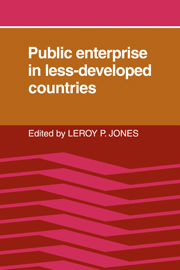Book contents
- Frontmatter
- Contents
- List of contributors
- List of figures and tables
- Preface
- 1 Introduction
- Part I Why public enterprise?
- Part II Principal-agent relationships: Who should control public enterprises?
- Part III How are decisions made in practice?
- 6 Comparing state enterprises across international boundaries: the Corporación Venezolana de Guayana and the Companhía Vale do Rio Doce
- 7 Decision structure, technological self-reliance, and public-enterprise performance
- 8 Labor–management conflict resolution in state-owned enterprises: a comparison of public- and private-sector practices in India
- Part IV How do public enterprises behave in international markets?
- Part V How does risk alter public-enterprise decisions?
- Part VI How are incentive structures to be designed?
- Part VII How does public enterprise compare with other intervention mechanisms in overcoming particular problems?
6 - Comparing state enterprises across international boundaries: the Corporación Venezolana de Guayana and the Companhía Vale do Rio Doce
Published online by Cambridge University Press: 04 August 2010
- Frontmatter
- Contents
- List of contributors
- List of figures and tables
- Preface
- 1 Introduction
- Part I Why public enterprise?
- Part II Principal-agent relationships: Who should control public enterprises?
- Part III How are decisions made in practice?
- 6 Comparing state enterprises across international boundaries: the Corporación Venezolana de Guayana and the Companhía Vale do Rio Doce
- 7 Decision structure, technological self-reliance, and public-enterprise performance
- 8 Labor–management conflict resolution in state-owned enterprises: a comparison of public- and private-sector practices in India
- Part IV How do public enterprises behave in international markets?
- Part V How does risk alter public-enterprise decisions?
- Part VI How are incentive structures to be designed?
- Part VII How does public enterprise compare with other intervention mechanisms in overcoming particular problems?
Summary
Because of the diverse forms of state-owned enterprises (SOEs), scholars still differ considerably over basic issues concerning their behavior. More agreement is possible, however, when a relatively homogeneous subset of state enterprises can be studied. Comparative analysis of Air France and of a state-owned agricultural enterprise in Cuba would probably offer little in the way of useful generalizations; it makes more sense to build up hypotheses from cases that are more likely to have commonalities. This chapter examines, through detailed case studies, two similar state-owned conglomerates in Venezuela and Brazil, the Corporaci6n Venezolana de Guayana (CVG) and the Companhia Vale do Rio Doce (CVRD), and constructs a model for analyzing the kind of behavior found to be typical in both.
Comparability of CVG and CVRD: a short description
As state-owned enterprises go, CVG and CVRD have significant similarities that provide a rich field for comparison. CVG was founded in 1960 as a regional development corporation whose ambit included the huge southeastern portion of Venezuela, at the time largely empty and backward, although blessed with important mineral and energy resources. CVG's original mandate was threefold: direct the nascent steel industry, build up the hydroelectric facilities in the area, and provide the human and physical infrastructure not only for these two industries but also for the development of new industries in Guayana.
The research for this chapter was made possible by support from the Corporación Venezolana de Guayana and the Harvard Institute for International Development, as well as by the cooperation of the Companhía Vale do Rio Doce. Much of the information was collected in the course of interviews with managers from the two companies during 1979. […]
- Type
- Chapter
- Information
- Public Enterprise in Less Developed Countries , pp. 103 - 128Publisher: Cambridge University PressPrint publication year: 1982
- 6
- Cited by



